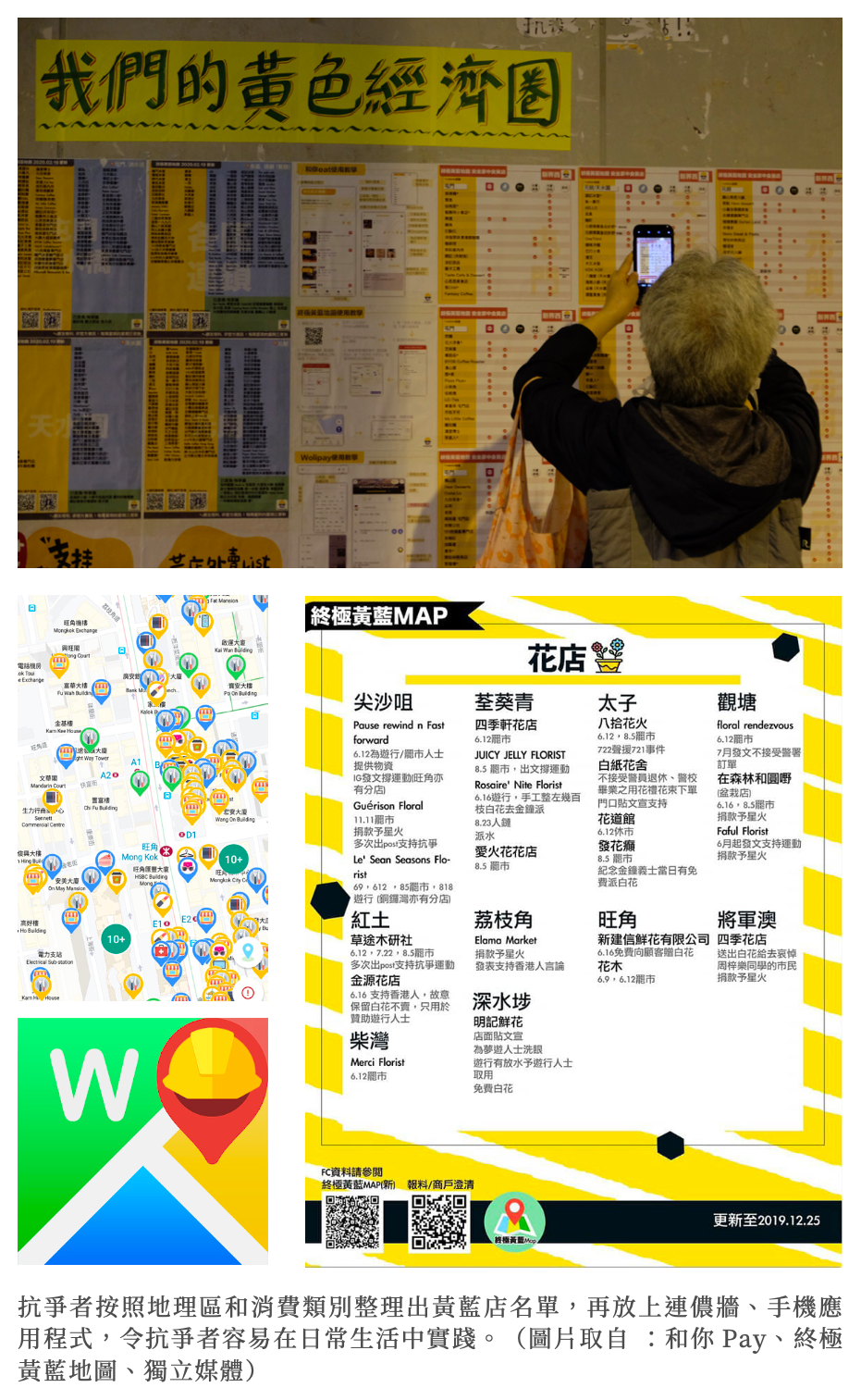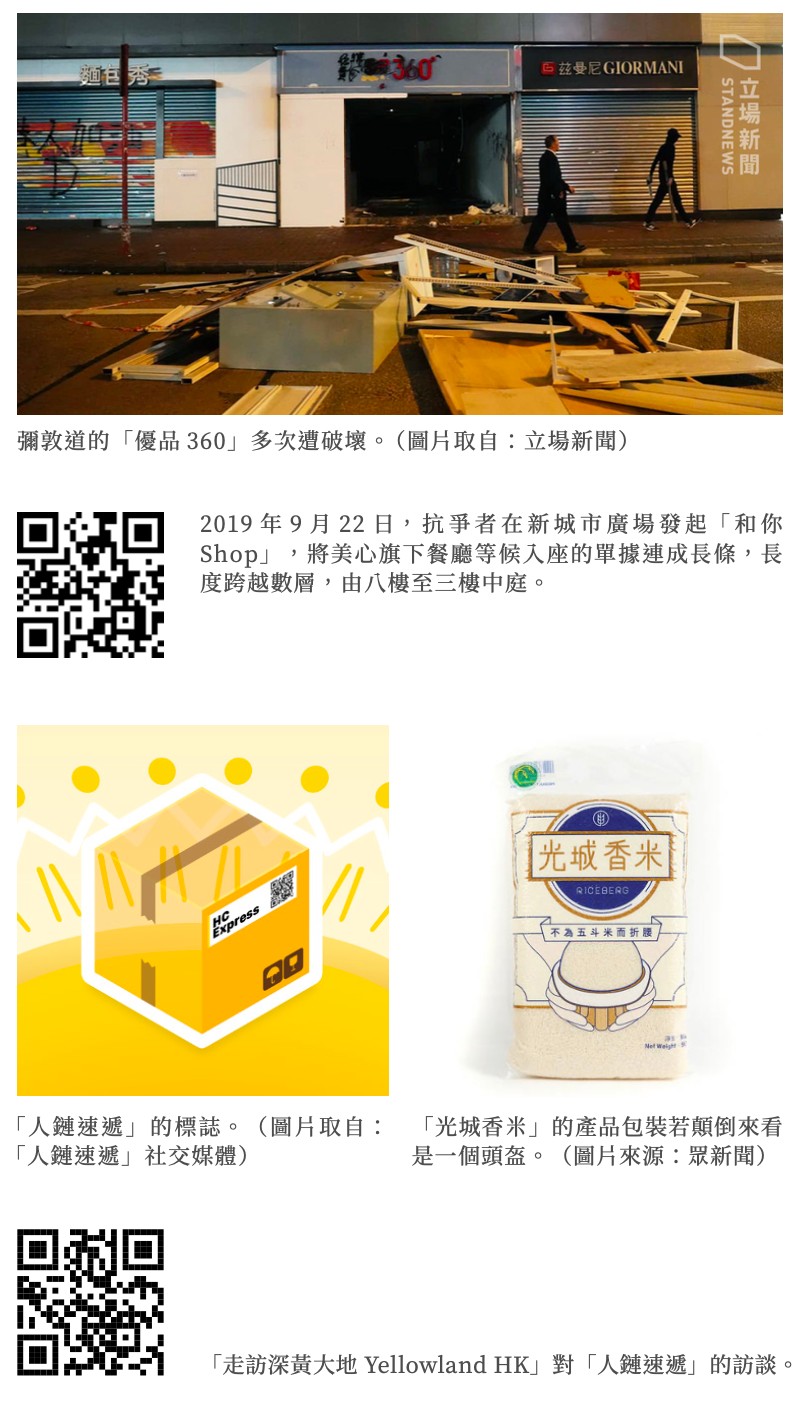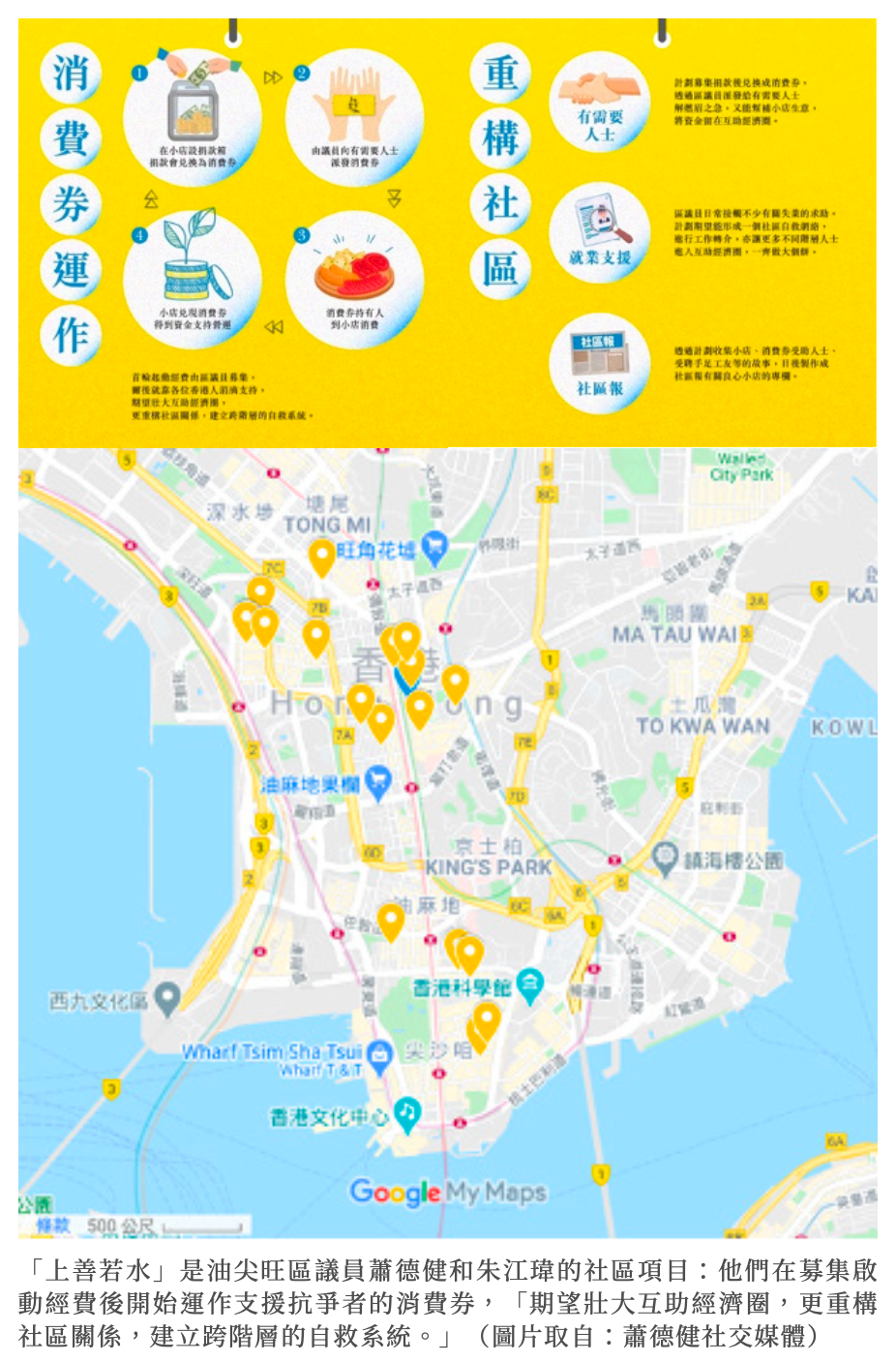
這是一個關於香港的寫作計劃,也是場記憶與遺忘的鬥爭。我們從2021年的6月9日開始每晚連載,梳理香港社會運動的歷史脈絡,以及從2019年春天至2021年,由《逃犯條例》修訂草案所引爆的民主運動的發展軌跡。希望這個書寫的嘗試,能在阻隔交流的石壁高牆上鑿出一個洞,帶來對話的可能,也煉成連結和反抗的起點。
The struggle beyond the streets (3): the yellow economic circle
"Yellow Economic Circle"
In the "anti-revision bill" movement, various businesses first expressed their support for the movement and offered support, and later protesters visited the "yellow shops" that supported the movement and resisted the "blue shops" that suppressed the movement. Under the continuous information collection, publicity and mobilization of the protesters' camp, the "yellow economic circle" (hereinafter referred to as "yellow circle") has gradually formed, and has been transformed from various events into continuous practices in daily life. Protesters use their consumption practices to implement their political ideas, which also have real economic impacts. On the other hand, the ubiquitous "yellow shop" network has also developed links with district councils, community networks, and trade unions in various districts. In 2020, when the street protests were silent, the physical space of "Yellow Shop" was able to gather "fellow travelers" and carry a social network that helped each other during the epidemic.
This chapter is divided into three parts. The first part introduces the formation of the "yellow circle"; the second part introduces the practice of the "yellow circle", including support for the network of fighters, consumer resistance in daily life, resource sharing and mutual assistance under the epidemic The third part introduces the meaning and limitations of the practice of "yellow circle".
1. The formation of the "yellow circle"
As early as the "anti-revision" movement broke out, more than 1,600 businesses expressed their support for the movement, distributed supplies to demonstrators, and responded to the "three strikes" (strikes, class strikes, and market strikes), which were called "yellow shops [1] " by protesters; Businesses who support the government and suppress protesters (for example: Yoshinoya fired advertising agency employees who mocked the police force , Wu Shuqing threatened middle school students who participated in strikes as school supervisors to withdraw from school ) are called "blue shops".
When various businesses showed their political stance in the incident, protesters mobilized to patronize "yellow shops" and boycott "blue shops". After the story of "Yellow Shop"'s support of the movement spread on social media platforms, there was a long queue in front of the restaurant the next day; "Blue Shop" was crowded. Since August 2019, demonstrators have even "renovated" "blue shops" to cause economic losses. Chinese banks and bookstores invested by the Chinese government, and the "MTR Corporation" of which the Hong Kong government is a major shareholder are all targets of "renovation".
As the number of "yellow shops" and "blue shops" continued to increase with the development of the movement, protesters systematically collected relevant reports, verified scattered information, and expanded the yellow-blue list to various industries. The demonstrators also posted the list of yellow and blue stores in various districts on the Lennon Wall; in order to facilitate the continuous patronage of the yellow stores in daily life, they also created a mobile application that combines the maps and business hours of the surrounding yellow and blue stores [2] . Residents of various districts have also set up regional "yellow economic circle" groups on social media to share their dining experience and food reviews at Huangdian. During the information collection, promotion, and discussion of the protesters' camp, the "yellow circle" has changed from various events to the continuous practice of citizens in their daily lives.

2. The practice of "yellow circle"
"Yellow shops" in various districts provide resources, space, and employment opportunities to protesters during the movement; protesters make political statements through continuous consumption and input resources to the "yellow circle". In 2020, the epidemic has plunged Hong Kong society into a cold winter. Epidemic prevention measures and political suppression have also made it difficult for citizens to gather in public spaces. In this context, the resource sharing cycle and mutual assistance formed by protesters and the "yellow circle" have played a big role. The "Huangdian" has also become a node for gathering "fellow people", opening up the possibility of developing new social relations.
2.1 "Huangdian" supports the protests
With the development of the movement, the "yellow circle" provides various corresponding support to the protesters. In the June 2019 parade, the "Yellow Shop" distributed drinks and food to protesters to show support; when the police force's crackdown intensified, the "Yellow Shop" began to collect helmets, gas masks, and protective equipment, and during the demonstrations Demonstrators provide safe shelter.
When the movement lasted for several months, some protesters faced difficulties in their livelihoods and were arrested and lost their jobs. The “yellow shop” provided three meals to the protesters who were blocked by the economy or lost their jobs; some “yellow shops” hired and found jobs after being arrested and released. Difficult protesters have even appeared as a job matching platform for the "Yellow Economic Circle"; when a large number of demonstrators were arrested and remanded, in order to provide better private meals for the protesters in prison, the "Yellow Shop" applied to become a supply of correctional institutions merchants, at a loss to provide meals to remands at low prices. On the other hand, due to the epidemic and political suppression, activities in public spaces have been restricted, and the "yellow shops" in various districts have become positions for gathering "fellow travelers". Protesters posted on the "Lennon Wall" in Huangdian to express their ideas, distributed community newspapers, consigned protesters' hand-made goods, and set up polling stations for pro-democracy elections.

2.2 Demonstrators' economic struggle
Using consumer behavior to express stance is not a new concept. In addition to the anti-sweatshop and pro-environmental consumer campaigns in the past few decades, Chinese people have also launched the economy of "patriotic buying domestic products and boycotting Japanese companies" when Sino-Japanese relations were tense. confrontation. In recent years, events such as movie star Du Wenze's remarks in support of Taiwan's Sunflower Movement, and Givenchy's juxtaposition of Taiwan and Hong Kong with other countries in the product pattern have led to large-scale boycotts by the state media and the public.
In the "anti-revision bill", protesters began to pay attention to the support of daily consumption as restaurants under the large chain "Maxim" were boycotted due to the founder's eldest daughter's high-profile support for the government, and many large shopping malls became the target of boycotts for suppressing demonstrations. And what capital is growing, thinking about how to reduce dependence on the regime and "blue" capital. A total of 72 branches of “Youpin 360” suffered varying degrees of damage due to being accused of being related to the Fujian Gang who attacked the protesters, and the profit recorded a 4.5% drop in 2020 compared to the previous year; “Yoshinoya” closed 10 branches in Hong Kong one after another; On the other hand, the passenger volume of the passenger services of the MTR Corporation decreased by 33.3% year-on-year, and the revenue decreased by 41.7% year-on-year.
On the other hand, driven by the "yellow circle", protesters are looking for "companions" in consumption in catering, retail, logistics, film and television, etc. Many of them are small community stores outside large chain groups. Protesters are also building new stores in industries long dominated by established capital. For example: because they did not want to use the Chinese-funded logistics "SF Express", some protesters set up "Human Chain Express" with "Huangdian" as a self-pickup point, and hired protesters as deliverymen; three students met in a telegram group , Seeing that the local rice market is monopolized by "Blue Shop" or Chinese capital, it develops "Guangcheng Fragrant Rice" by itself, and arranges the development of production lines, advertising, market development, packaging, and delivery .

2.3 Mutual aid network under the epidemic
In the first half of 2020, it was difficult to find a mask in the whole city. Citizens were running around for masks, and there were long queues. However, the government was slow to arrange the distribution of anti-epidemic materials. At that time, many "yellow shops" collected anti-epidemic materials and sent them to Distributed by grassroots citizens. On the other hand, many "yellow circle" restaurants have suffered from dismal business and are on the verge of closing down under the government's "dine-in ban". At this time, the continuous consumption of the protesters' camp became the lifeboat of the "yellow shop", and various districts set up regional "yellow shop" takeaway platforms, which not only supported the business of the "yellow shop", but also hired protesters as takeaway workers to increase employment. Protesters have also held Hong Kong's "yellow circle" consumption season several times. For example, protesters are encouraged to spend in yellow shops during the " May 1st Golden Week ". A total of 2,305 shops participated in the event, more than 400,000 people responded, and the total turnover more than 100 million yuan. It is worth noting that the multi-district "yellow circle" has launched a regional yellow shop "storage stamp" activity and joint discounts to prevent protesters from concentrating on well-known yellow shops, but to support different yellow shops on average. A "yellow shop" owner mentioned in an interview that the "yellow circle" in his mind should be a circle that develops horizontally: " When you are 'punishing' me, I will bring other stores; or you 'punishing' Me, I'll give you discounts from other stores, so you'll 'punish' two stores at the same time. "
Under the epidemic, the "yellow circle" is a network of resource sharing and mutual benefit. In the face of the unemployment of grassroots employees during the epidemic, the meal voucher program initiated by "Parents" and "Huangdian" in the past had greater demand, but Huangdian's own business was also facing difficulties, so the multi-district councillors cooperated with the Huangdian network Implement community self-service meal coupons, provide start-up funds or raise funds from the public to buy meal coupons from the "yellow shop" to support the operation, and protesters in need can go to the "yellow shop" to use the meal coupons for free. For example: Distributing meal coupons to protesters in 2019 to relieve economic difficulties, and cooperating with more than 150 district councillors and nearly 400 "yellow shops" during the epidemic, using community anti-epidemic coupons to provide students in need and the unemployed apply for meal allowances. In this process, the beneficiary can establish a relationship with the "Huangdian" again.


3. The meaning and challenges of the "yellow circle"
In Hong Kong, rents have been high for a long time, the usual consumption choices of ordinary citizens are monopolized by a handful of chain groups, and the influence of Chinese capital is omnipresent. Until 2019, under the energy of the "Anti-Amendment Bill" movement, for the first time, citizens used consumption to make political statements in their daily life on a large scale. ', which is undoubtedly a great improvement. On the other hand, with the development of the movement, in 2020, when it is difficult for protesters to demonstrate in public spaces, "Yellow Shops", as commercial spaces in various districts, can not only continue to distribute news of the movement, but also carry new social relations. , connecting fellow travelers, and opening up a network of resource sharing and mutual assistance under the economic depression.
However, in practice, the "yellow circle" still faces many challenges and limitations. First of all, although the protesters hope to get rid of their dependence on Chinese capital and "blue" capital, if considering the owner of the shop lease, the production of raw materials and products, it is necessary to ensure that every link in the supply chain comes from "yellow shops" very difficult. Furthermore, although the "yellow circle" brings certain economic influence, the "yellow circle" cannot cover the major industries that account for the highest GDP (for example: finance, insurance, tourism). If protesters want to use the "yellow circle" "Pressuring the government and pro-establishment forces has limited effect. On the other hand, the nature of the “yellow shop” is a profit-making business, and there is an employment relationship. Although the owner of the “yellow shop” supports the movement, there are also problems with the whereabouts of donations, uneven food quality, labor rights and exploitation. For example, some protesters exposed through the "labor group" that "Shanxin Xiaoguan" fired employees and refused to pay the 7-day notice and delayed payment. Only under the pressure of public opinion did they admit to mishandling and pay the employees.
On the other hand, since the "yellow circle" appeared in the "anti-revision bill", the political suppression has not subsided . Some "yellow shops" were threatened by landlords and refused to renew their leases, and employees were ambushed. Under the epidemic, "yellow shops" are often reported by government supporters for epidemic prevention measures [3] and targeted by law enforcement officers. Whether the space of "yellow shops" can be maintained also faces challenges.
Note:
[1] In the "Umbrella Movement", the occupiers used "yellow ribbons" as symbols, and citizens used "yellow shops" to refer to businesses supporting the democratic movement.
[2] For example: "Eat with you", "Pay with you", "WhatsGap", "Conscience Guide" and other mobile applications
[3] Leung Chun-ying, vice chairman of the National Committee of the Chinese People's Political Consultative Conference and former chief executive, even called on supporters to actively report Huangdian on his social networking site, so that law enforcement officers "enforce the law strictly"
What Happened in Hong Kong is a writing project about Hong Kong and a struggle between memory and forgetting. We start serialization every night from June 9, 2021, to sort out the historical context of social movements in Hong Kong, as well as the development trajectory of the pro-democracy movement detonated by the draft amendment to the Fugitive Offenders Ordinance from the spring of 2019 to 2021. It is hoped that this writing attempt can cut a hole in the high stone wall that blocks communication, bring the possibility of dialogue, and make it a starting point for connection and resistance.
"What Happened in Hong Kong" Traditional e-book (PDF) download:
tinyurl.com/TC-WhatHappenedinHK
"What Happened in Hong Kong" Simplified eBook (PDF) Download:
tinyurl.com/SC-WhatHappenedinHK
Like my work?
Don't forget to support or like, so I know you are with me..
Comment…